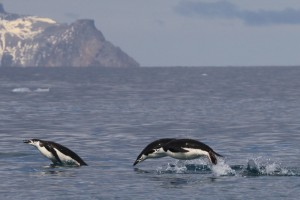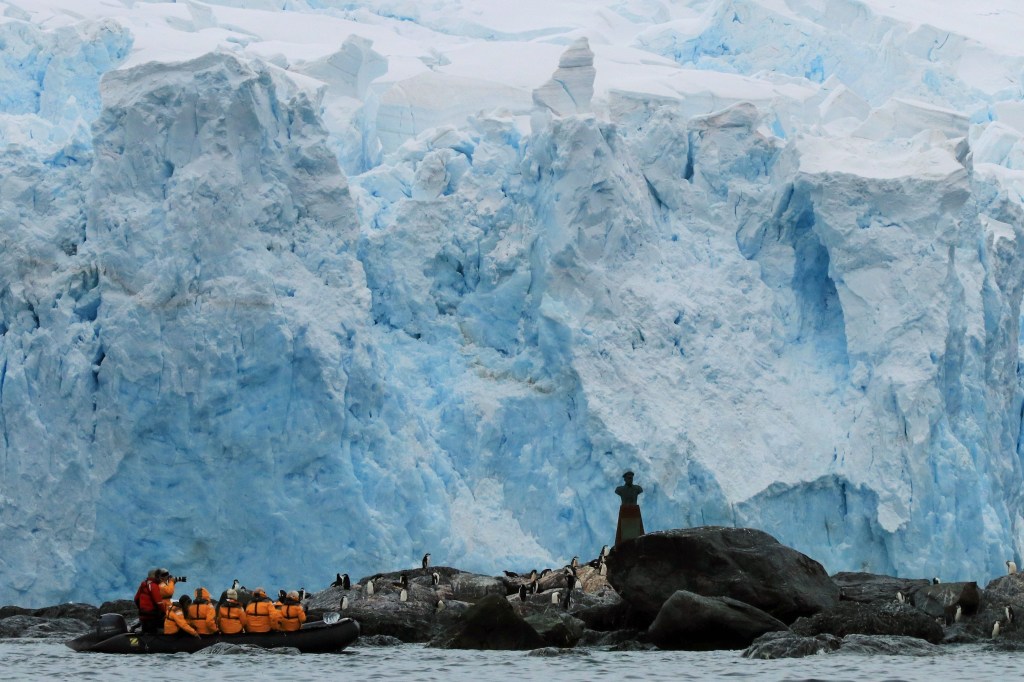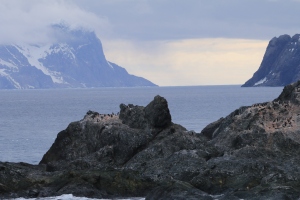We are now on the south coast of Elephant Island in the South Shetland island chain at Muckle Bluff. The word “muckle” is Scottish for “large” and everything here is supersized.
Let’s start with the Endurance Glacier (named for Shackleton’s expedition shipwrecked here for 4 1/2 months on the opposite side of the island). The calving glacial face at the ocean is 3.73 miles wide. It crosses the width of the 16.8 mile island, hugging 2,799 foot tall mountain peaks. This heavily crevassed glacier has retreated up to 5,000 feet between 1990 and 2015. Besides global warming, the exposed face is battered with winds over 100 mph and up to 60 foot waves.
On our zodiac cruise along the coast line, we found such beautiful blue ice formed into surreal shapes. We visited Macaroni and Chinstrap Penguin nesting grounds from the water. I love the macaroni penguin picture, because you can see the feathers clearly.
How about this for a jaw dropping backdrop?
After checking out things from the water we visited with the nesting Chinstrap Penguin colony. These little guys are quite the climbers.
It’s so steep that they hop-hop-hop all the way down when it’s time to go eat. I can’t imagine how many calories they need to eat each day just for this exertion.
We also saw bleached out whale bones. The baleen in the second picture is from a whale’s mouth, used to sieve food and expel water. The ends look and feel like straw. The middle fluted part feels like a fingernail. Long ago, baleen was used in whips, corset stays and other products.
The picture above is one of my favorites. The lady is taking a picture out to sea, but look at all the penguins lined up behind her–and she doesn’t know it. Makes me smile.
There are many special critters here. On the left is one of the best Antarctic predators– the Leopard Seal. Yet, walking behind him wobbles dinner–the penguin. Leopard Seals can weigh 1,300 pounds and are 11 feet long. They do not breed on land like other seals and are loners. Their babies are born on the ice, nestled in a freezing hole by the mother. They’re only predator is a killer whale. Zoom on the picture of the Leopard seal and the Weddell seal to the right. Are they crying? Don’t shed tears for them—this is the way they eliminate saline from the ocean. Also, examine the flipper of the Weddell. Do you notice something odd? Fingernails, perhaps? They are both “earless” seals.
Watching “porpoising” penguins is mesmerizing. So fast. So graceful!
























 Endurance Glacier (named after the rescue) is a piedmont glacier. Do you know what that means? Did you know there are so many glaciers in Antarctica that many have never been named? Maybe your class can petition to name one. See the blue ice? This means it’s old and compressed.
Endurance Glacier (named after the rescue) is a piedmont glacier. Do you know what that means? Did you know there are so many glaciers in Antarctica that many have never been named? Maybe your class can petition to name one. See the blue ice? This means it’s old and compressed.





